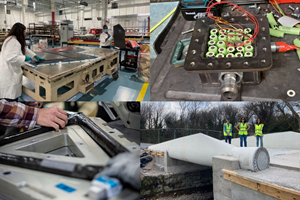Math, science, data and the composites industry’s future
My first plant tour as a business journalist was in February 1997. Fast forward to 2018 and suddenly what was old is new again.
My first plant tour as a business journalist was in February 1997. I was, at the time, a senior editor at Injection Molding magazine and traveled up to northern Wisconsin to visit a custom injection molder there. I was traveling with John Bozzelli, who, at the time, had just launched a consultancy, espousing the virtues of “scientific molding.” He had been called to this Wisconsin molding facility to help the company increase its operational efficiency.
Scientific molding, as the phrase implies, is the application of scientific and mathematical principles to the injection molding process, and is designed to increase molding process consistency, reduce waste and increase finished part quality (sound familiar?).
I remember thinking at the time that such principles certainly could/should have been applied many years previously. But, in fact, the molding industry’s efforts to meet production goals were still beset by dependence on human operators. That is, there were, in many plants, certain people who “knew” how to make certain injection molding machines operate properly. Indeed, I once had a plant manager point to an idle molding machine and tell me, “Only Mike on third shift can make this machine and mold produce good parts.”
John’s mission, early on, was to move molders away from this dependency by helping operators and plant managers to better understand the physics governing the injection molding process. The ultimate goal was to help molders build robust, repeatable molding processes that produce quality parts with little or no human intervention.
The first step in this transformation was a machine audit, and that’s what I witnessed in frigid Wisconsin — watching and learning as John assessed this molder’s machines. Much of this work was basic math, verifying that what the machine’s controls said the machine was doing was reflected in reality (often it was not), and then working to align those controls with reality. It was, basically, data collection, calculation, assessment and adjustment. If we are in or on the cusp of Industry 4.0 today, then what John and I were doing in 1997 must have been Industry Beta.
Of course, getting molders to do simple math was not the highest hurdle John had to clear. The biggest barrier, more often than not, was not mathematical but sociological: Getting the company and its employees to change the way they think about manufacturing, to change the company management and shop floor culture — top to bottom — to embrace the concept of science-centric manufacturing.
Fast forward to 2018 and suddenly what was old is new again. Science- or math-based manufacturing is now known as the Industrial Internet of Things (IIoT), or the aforementioned Industry 4.0. And while the overarching goals are the same — systematic, disciplined, data-based processing — the tools available to us are much more sophisticated. Raw computing power, cloud-based data storage, remote sensing and artificial intelligence, unimaginable in 1997, now simplify and streamline the effort to harness the power and precision of data-based manufacturing. And when implemented well, the results can be impressive, increasing efficiencies, reducing cycle times and waste, and ensuring the consistency and repeatability of composites manufacturing processes.
What has not changed, however, is cultural intransigence, the built-in institutional reluctance in a composites fabricator’s facility to seek out and apply new technologies. The myriad (understandable) reasons for this include lack of resources, lack of time, fear of change, uncertainty of results. What is certain, however, is that the entire composites industry, just as the injection molding industry did more than 20 years ago, must begin to embrace the systematic use of data, particularly if it expects to deliver the process control, production speed and product quality sufficient to establish composites as the advanced materials of the 21st Century.
Related Content
The future of carbon fiber manufacture
Later this month, CW’s 25th anniversary Carbon Fiber Conference promises to be among the most important as dynamic market forces are putting unusual pressure on the carbon fiber supply chain.
Read MoreCompositesWorld is on the road again
Since CW’s infancy, its editors have strived to imbue its coverage with a sense of place, whether that’s through plant tours, facility visits or trade shows. After a pandemic, this has never seemed more important.
Read MoreWhy aren't composites synonymous with infrastructure?
The U.S. seems poised to invest heavily in infrastructure. Can the composites industry rise to the occasion?
Read MoreAs 2023 begins, a look back at trending CW topics in 2022
With 2022 now behind us, CW’s editor-in-chief Jeff Sloan takes a look at the CW stories last year that received the most reader attention.
Read MoreRead Next
Composites end markets: Energy (2024)
Composites are used widely in oil/gas, wind and other renewable energy applications. Despite market challenges, growth potential and innovation for composites continue.
Read MoreCW’s 2024 Top Shops survey offers new approach to benchmarking
Respondents that complete the survey by April 30, 2024, have the chance to be recognized as an honoree.
Read MoreFrom the CW Archives: The tale of the thermoplastic cryotank
In 2006, guest columnist Bob Hartunian related the story of his efforts two decades prior, while at McDonnell Douglas, to develop a thermoplastic composite crytank for hydrogen storage. He learned a lot of lessons.
Read More













.jpg;maxWidth=300;quality=90)











